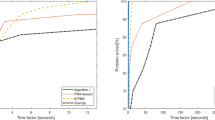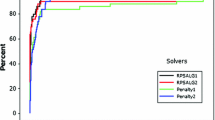Abstract
The second-order cone program (SOCP) is an optimization problem with second-order cone (SOC) constraints and has achieved notable developments in the last decade. The classical semi-infinite program (SIP) is represented with infinitely many inequality constraints, and has been studied extensively so far. In this paper, we consider the SIP with infinitely many SOC constraints, called the SISOCP for short. Compared with the standard SIP and SOCP, the studies on the SISOCP are scarce, even though it has important applications such as Chebychev approximation for vector-valued functions. For solving the SISOCP, we develop an algorithm that combines a local reduction method with an SQP-type method. In this method, we reduce the SISOCP to an SOCP with finitely many SOC constraints by means of implicit functions and apply an SQP-type method to the latter problem. We study the global and local convergence properties of the proposed algorithm. Finally, we observe the effectiveness of the algorithm through some numerical experiments.
Similar content being viewed by others
Notes
For two sets \(X\subseteq Y\), the distance from \(X\) to \(Y\) is defined as \({\mathop {\mathrm{dist}\,}}(X,Y)\,{:=}\,\sup _{y\in Y}{\inf }_{x\in X }{\Vert }x-y{\Vert }\).
This can be regarded as a kind of Cottle’s constraint qualification for \(\mathrm{SOCP}(x^{*},\varepsilon )\).
The fact that \(u^{\top }v=0, u\in {\mathop {\mathrm{int}}}\,\mathcal{K }^m, v\in \mathcal{K }^m \Rightarrow v=0\) is used here.
This spectral decomposition process may be expensive computationally, when the size of \(B_k\) becomes huge. In that case, it may be reasonable to use the modified Cholesky factorization [5] to make \(B_k\) positive-definite.
The origin \(x=0\) always lies in the interior of the feasible region, since we have \(-b^s(t)\in {\mathop {\mathrm{int}}}\, \mathcal{K }^{m_s}\) from \(-b^s_1(t)-\Vert (-b^s_2(t),\ldots ,-b^s_{m_s}(t))^{\top }\Vert >0\) for all \(t\in T\).
We also suppose that Assumption 4.1(b) holds.
References
Alizadeh, F., Goldfarb, D.: Second-order cone programming. Math. Program. 95, 3–51 (2003)
Bonnans, J.F., Ramírez, C.H.: Perturbation analysis of second-order cone programming problems. Math. Program. 104, 205–227 (2005)
Floudas, C.A., Stein, O.: The adaptive convexification algorithm: a feasible point method for semi-infinite programming. SIAM J. Optim. 18, 1187–1208 (2007)
Fukushima, M., Luo, Z.Q., Tseng, P.: Smoothing functions for second-order cone complementarity problems. SIAM J. Optim. 12, 436–460 (2001)
Gill, P.E., Murray, W., Wright, M.H.: Practical Optimization. Academic Press, London (1981)
Goberna, M.A., López, M.A.: Semi-Infinite Programming–Recent Advances. Kluwer, Dordrecht (2001)
Gramlich, G., Hettich, R., Sachs, E.W.: Local convergence of SQP methods in semi-infinite programming. SIAM J. Optim. 5, 641–658 (1995)
Hayashi, S., Wu, S.-Y.: An explicit exchange algorithm for linear semi-infinite programming problems with second-order cone constrains. SIAM J. Optim. 20, 1527–1546 (2009)
Hayashi, S., Yamashita, N., Fukushima, M.: A combined smoothing and regularization method for monotone second-order cone complementarity problems. SIAM J. Optim. 15, 593–615 (2005)
Hettich, R.: An implementation of a discretization method for semi-infinite programming. Math. Program. 34, 354–361 (1986)
Hettich, R., Kortanek, K.O.: Semi-infinite programming: theory, methods, and applications. SIAM Rev. 35(3), 380–429 (1993)
Kato, H., Fukushima, M.: An SQP-type algorithm for nonlinear second-order cone programs. Optim. Lett. 1, 129–144 (2007)
Lai, H.C., Wu, S.-Y.: On linear semi-infinite programming problems. Numer. Funct. Anal. Optim 13, 287–304 (1992)
Li, D.H., Qi, L., Tam, J., Wu, S.-Y.: A smoothing Newton method for semi-infinite programming. J. Glob. Optim. 30, 169–194 (2004)
Lobo, M.S., Vandenberghe, L., Boyd, S., Lebret, H.: Applications of second-order cone programming. Linear Algebra Appl. 284, 193–228 (1998)
López, M.A., Still, G.: Semi-infinite programming. Eur. J. Oper. Res. 180, 491–518 (2007)
Okuno, T., Hayashi, S., Fukushima, M.: A regularized explicit exchange method for semi-infinite programs with an infinite number of conic constraints. SIAM J. Optim. 22, 1009–1028 (2012)
Pereira, A., Costa, M., Fernandes, E.: Interior point filter method for semi-infinite programming problems. Optimization 60, 1309–1338 (2011)
Pereira, A., Fernandes, E.: A reduction method for semi-infinite programming by means of a global stochastic approach. Optimization 58, 713–726 (2009)
Qi, L., Wu, S.-Y., Zhou, G.: Semismooth Newton methods for solving semi-infinite programming problems. J. Global Optim. 27, 215–232 (2003)
Reemtsen, R.: Discretization methods for the solution of semi-infinite programming problems. J. Optim. Theory Appl. 71, 85–103 (1991)
Reemtsen, R., R\(\ddot{\text{u}}\)ckmann, J.-J. (eds.): Semi-Infinite Programming. Kluwer, Boston (1998)
Sturm, J.F.: Using SeDuMi 1.02, a MATLAB toolbox for optimization over symmetric cones. Optim. Methods Softw. 11, 625–653 (1999)
Tanaka, Y., Fukushima, M., Ibaraki, T.: A globally convergent SQP method for semi-infinite nonlinear optimization. J. Comput. Appl. Math. 23, 141–153 (1988)
Toh, K.C., Todd, M.J., T\(\ddot{\text{u}}\)t\(\ddot{\text{u}}\)nc\(\ddot{\text{u}}\), R.H.: SDPT3–a MATLAB software package for semidefinite programming, version 2.1. Optim. Methods Softw. 11, 545–581 (1999)
Wang, Y., Zhang, L.: Properties of equation reformulation of the Karush-Kuhn-Tucker condition for nonlinear second order cone optimization problems. Math. Meth. Oper. Res. 70, 195–218 (2009)
Wu, S.-Y., Li, D.H., Qi, L., Zhou, G.: An iterative method for solving KKT system of the semi-infinte programming. Optim. Methods Softw. 20, 629–643 (2005)
Yamashita, H., Yabe, H.: A primal-dual interior point method for nonlinear optimization over second-order cones. Optim. Methods Softw. 24, 407–426 (2009)
Acknowledgments
We would like to thank two anonymous referees for their valuable comments and suggestions.
Author information
Authors and Affiliations
Corresponding author
Additional information
This research was supported in part by Grant-in-Aid for Scientific Research from Japan Society for the Promotion of Science.
Rights and permissions
About this article
Cite this article
Okuno, T., Fukushima, M. Local reduction based SQP-type method for semi-infinite programs with an infinite number of second-order cone constraints. J Glob Optim 60, 25–48 (2014). https://doi.org/10.1007/s10898-013-0063-0
Received:
Accepted:
Published:
Issue Date:
DOI: https://doi.org/10.1007/s10898-013-0063-0




